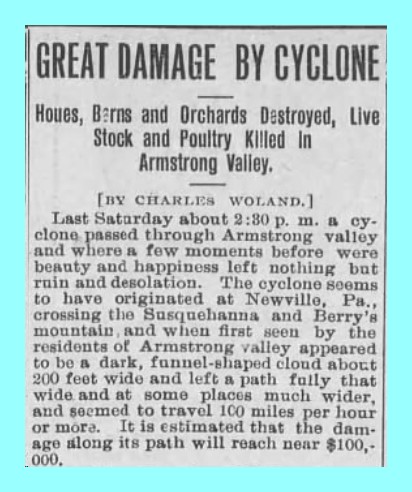Part 2 of 3 posts on the Great Cyclone of June, 1910, featuring news articles from local and area newspapers.
From the Lykens Standard, June 24, 1910:
GREAT DAMAGE BY CYCLONE
HOUSES, BARNS AND ORCHARDS DESTROYED
LIVESTOCK AND POULTRY KILLED IN ARMSTRONG VALLEY
[By Charles Woland]
Last Saturday about 2:30 p. m. a cyclone passed through Armstrong Valley where a few moments before were beauty and happiness left nothing but ruin and desolation. The cyclone seems to have originated at Newville, Pennsylvania, crossing the Susquehanna and Berry’s Mountain and when first seen by the residents of Armstrong Valley appeared o be a dark, funnel-shaped cloud about 200 feet wide and left a path fully that wide and at some places much wider, and seemed to travel 100 miles per hour or more. It is estimated that the damage along its path will reach near $100,000.
A path was cleared down Berry’s Mountain and the barn of Charles Yeager partly destroyed. On the farm of George Keiter, occupied by Hiram Stoneroad was also carried a considerable distance. After the house and everything had been swept away their small child was found in the cellar under its overturned cradle, unharmed. At this place chickens were swept in the air and literally torn to pieces, and articles of furniture were found two miles distant.
On the farm occupied by Ellsworth Fitting the barn was demolished, house damaged and the orchard so completely uprooted that only a locust tree remains standing by the farm.
On the Henninger farm, occupied by Penrose Miller, the barn was destroyed, the house damaged and the orchard uprooted.
On the Beard farm the barn was destroyed and the upper story of the brick house damaged.
The picnic grove owned by Washington Enders, was uprooted.
When the barn on the Issac Enders farm collapsed one cow was killed.
The next place on the path of the storm was the town of Enders, where almost every house and stable was pushed partly or altogether from their foundations. Some were struck by falling trees or telegraph poles and others uprooted and many windows broken.
The belfry and tower of the Lutheran church was blown down and now rests in a near lot. Every telephone was out of service.
The new barn on the Wilbert farm was partly destroyed. Here a path was cut clear through a tract of timber to the farm of Philip Dietrich, where the barn was left a heap of wreckage and the house damaged. One horse was killed, a flock of chickens destroyed and the orchard uprooted.
On the Thomas Hoover farm the barn was entirely destroyed, and only part of the first story of the house remains standing. All outbuildings and machinery were also destroyed, the orchard uprooted and articles of furniture found miles away. Some paper money was swept away and has not yet been recovered.
A tract of woodland on the J. Walters farm was destroyed, and the barn on the Sweigard farm slightly damaged and many trees uprooted.
A tract of woodland owned by James Hoffman, one by John Enders and Uriah Snyder were also badly uprooted.
The barn on the Enders farm was partly destroyed and both telephone lines were down at this point.
On the small farm owned by Lewis Enders the orchard was uprooted, the barn and blacksmith shop blown to pieces and only one story of the house remains standing. The family was away from home during the storm.
The barn on the Shultz farm was pushed from its foundation and the implement shed on the Rummel farm with all implements destroyed. When the cyclone passed over the large dam it drew a cloud of water almost a hundred feet high. Here the cyclone passed over the mountain, carrying with it many destroyed articles. It is almost miraculous that such great damage was done without the loss of a human life. The fact that not more cattle were killed was because they were nearly all in the fields.
It is estimated that fully a thousand people took in the sights along the line of ruin Sunday.
About the same time the cyclone passed over the Armstrong Valley, a hail storm passed through the upper end of Small Valley and the vicinity of Carsonville, clopping the trees of their foliage and fruit and leaving the harvest worthless at many places.
________________________________________
Article from Newspapers.com.
Corrections and additional information should be added as comments to this post.
